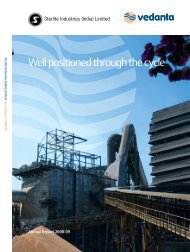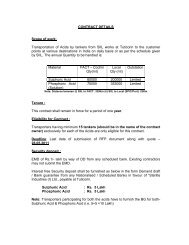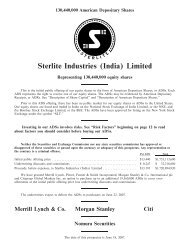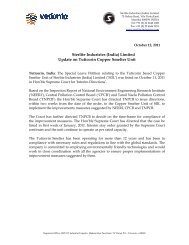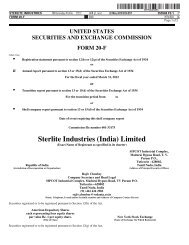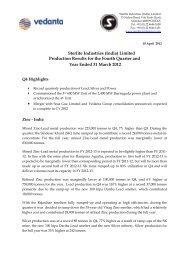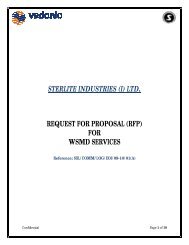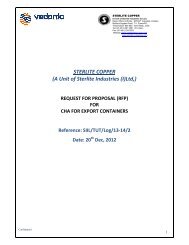Sterlite Industries (India) Limited - Sterlite Industries India Ltd.
Sterlite Industries (India) Limited - Sterlite Industries India Ltd.
Sterlite Industries (India) Limited - Sterlite Industries India Ltd.
Create successful ePaper yourself
Turn your PDF publications into a flip-book with our unique Google optimized e-Paper software.
SFAS No. 161, “Disclosures about Derivative Instruments and Hedging Activities — an amendment of FASB Statement No. 133”<br />
In March 2008, the FASB issued SFAS 161, “Disclosures about Derivative Instruments and Hedging Activities — an amendment of FASB<br />
Statement No. 133,” or SFAS 161, which modifies and expands the disclosure requirements for derivative instruments and hedging activities.<br />
SFAS 161 requires that objectives for using derivative instruments be disclosed in terms of underlying risk and accounting designation and<br />
requires quantitative disclosures about fair value amounts and gains and losses on derivative instruments. It also requires disclosures about<br />
credit-related contingent features in derivative agreements. SFAS 161 is effective for financial statements issued for fiscal years and interim<br />
periods beginning after November 15, 2008, with early application encouraged. SFAS 161 encourages, but does not require, comparative<br />
disclosures for earlier periods at initial adoption. Our management is currently evaluating the impact, if any, the adoption of SFAS 161 will<br />
have on our financial reporting and disclosures.<br />
FASB Staff Position No. FAS 115-2 and FAS 124-2, “Recognition and Presentation of Other-Than-Temporary Impairments”<br />
In April 2009, the FASB issued FASB Staff Position No. FAS 115-2 and FAS 124-2, “Recognition and Presentation of Other-Than-<br />
Temporary Impairments,” or FAS 115-2 and FAS 124-2. The objective of an other-than-temporary impairment analysis under existing U.S.<br />
GAAP is to determine whether the holder of an investment in a debt or equity security for which changes in fair value are not regularly<br />
recognized in earnings (such as securities classified as held-to-maturity or available-for-sale) should recognize a loss in earnings when the<br />
investment is impaired. An investment is impaired if the fair value of the investment is less than its amortized cost basis. We are currently<br />
evaluating the impact of FAS 115-2 and FAS 124-2 on our consolidated financial position and results of operation for items within the scope of<br />
FAS 115-2 and FAS 124-2 which becomes effective beginning with our first quarter of 2010.<br />
FASB Staff Position No. FAS 107-1 and APB 28-1, “Interim Disclosures about Fair Value of Financial Instruments”<br />
In April 2009, the FASB issued FASB Staff Position No. FAS 107-1 and APB 28-1, “Interim Disclosures about Fair Value of Financial<br />
Instruments,” or FAS 107-1 and APB 28-1. FAS 107-1 and APB 28-1 amends FASB Statement No. 107, “Disclosures about Fair Value of<br />
Financial Instruments,” to require disclosures about fair value of financial instruments for interim reporting periods of publicly traded<br />
companies as well as in annual financial statements. FAS 107-1 and APB 28-1 also amends APB Opinion No. 28, “Interim Financial<br />
Reporting,” to require those disclosures in summarized financial information at interim reporting periods. We are currently evaluating the<br />
impact of FAS 107-1 and APB 28-1 on our consolidated financial position and results of operation for items within the scope of FAS 115-2 and<br />
FAS 124-2 which become effective beginning with our first quarter of 2010<br />
FSP FAS 142-3, “Determination of the Useful Life of Intangible Assets”<br />
In April 2008, the FASB issued FSP FAS 142-3, “Determination of the Useful Life of Intangible Assets,” or FSP 142-3. This guidance is<br />
intended to improve the consistency between the useful life of a recognized intangible asset under SFAS No. 142, “Goodwill and Other<br />
Intangible Assets,” or SFAS 142, and the period of expected cash flows used to measure the fair value of the asset under SFAS 141R when the<br />
underlying arrangement includes renewal or extension of terms that would require substantial costs or result in a material modification to the<br />
asset upon renewal or extension. Companies estimating the useful life of a recognized intangible asset must now consider their historical<br />
experience in renewing or extending similar arrangements or, in the absence of historical experience, must consider assumptions that market<br />
participants would use about renewal or extension as adjusted for FAS 142’s entity-specific factors. FSP 142-3 is effective for us beginning<br />
April 1, 2009. We will be required to adopt this FSP prospectively for all assets acquired after April 1, 2009 and early adoption is prohibited.<br />
Its effects on future periods will depend on the nature and specific facts of assets acquired subject to FAS No. 142.<br />
FSP FAS 132(R)-1, “Employers’ Disclosures about Postretirement Benefit Plan Assets”<br />
In December 2008, the FASB issued FSP FAS 132(R)-1, “Employers’ Disclosures about Postretirement Benefit Plan Assets,” or FSP 132<br />
(R)-1. This guidance amends FAS No. 132(R), “Employers’ Disclosures about Pensions and Other Postretirement Benefits,” to require more<br />
detailed disclosures about the fair value measurements of employers’ plan assets including (a) investment policies and strategies; (b) major<br />
categories of plan assets; (c) information about valuation techniques and inputs to those techniques, including the fair value hierarchy<br />
classifications (as defined by FAS No. 157) of the major categories of plan assets; (d) the effects of fair value measurements using significant<br />
unobservable inputs (level 3) on changes in plan assets; and (e) significant concentrations of risk within plan assets. The disclosures required<br />
by the FSP is effective for us beginning April 1, 2009. This statement does not impact the consolidated financial results as it is disclosure-only<br />
in nature.<br />
FSP SFAS 165, “Subsequent Events”<br />
In May 2009, the FASB issued FSP SFAS No. 165, “Subsequent Events,” or SFAS 165, which provides guidance on accounting for and<br />
disclosures of events that occur after the balance sheet date but before financial statements are issued or are available to be issued. SFAS 165 is<br />
effective for fiscal years and interim periods ending after June 15, 2009. Our management is currently evaluating the impact, if any, the<br />
adoption of SFAS 165 will have on our financial reporting and disclosure.<br />
FSP SFAS 168, “The FASB Accounting Standards Codification and the Hierarchy of Generally Accepted Accounting Principles”<br />
In June 2009, FASB issued FSP SFAS No. 168, “The FASB Accounting Standards Codification and the Hierarchy of Generally Accepted<br />
Accounting Principles,” or SFAS 168. This guidance replaces FASB Statement No. 162, “The Hierarchy of Generally Accepted Accounting<br />
Principles,” or SFAS 162. The FASB Accounting Standards Codification will be the source of authoritative US GAAP recognized by the<br />
FASB to be applied by non-governmental entities. Rules and interpretive releases of the SEC under the authority of federal securities laws are<br />
also sources of authoritative GAAP for SEC registrants. On the effective date of SFAS 168, the FASB Accounting Standards Codification will<br />
supersede all then-existing non-SEC accounting and reporting standards. All other non-grandfathered non-SEC accounting literature not<br />
included in the FASB Accounting Standards Codification will become non-authoritative. SFAS 168 is effective for financial statements issued<br />
for fiscal years and interim periods ending after September 15, 2009. Once the FASB Accounting Standards Codification is in effect, all of its<br />
content will carry the same level of authority, effectively superseding SFAS 162. The issuance of SFAS 168 (and the FASB Accounting<br />
Standards Codification) will not change US GAAP except for certain non-public non-governmental entities and accordingly, the adoption of<br />
SFAS 168 will not have any impact on our financial reporting and disclosures.<br />
FASB Staff Position No. FAS 141(R)-1, “Accounting for Assets Acquired and Liabilities Assumed in a Business Combination That Arise<br />
from Contingencies”<br />
In April 2009, the FASB issued FASB Staff Position No. FAS 141(R)-1, “Accounting for Assets Acquired and Liabilities Assumed in a<br />
Business Combination That Arise from Contingencies,” or FSP 141(R)-1, to amend and clarify the initial recognition and measurement,<br />
subsequent measurement and accounting, and related disclosures arising from contingencies in a business combination under SFAS 141(R).<br />
Our management is currently evaluating the impact, if any, the adoption of FSP 141(R)-1 will have on our financial reporting and disclosures,<br />
which will become effective beginning with our first quarter of 2010.<br />
Emerging Issues Task Force (“EITF”) 08-6, “Equity Method Investment Accounting Considerations”<br />
In November 2008, the FASB issued EITF 08-6, “Equity Method Investment Accounting Considerations,” or EITF 08-6, which clarifies the<br />
accounting for transactions such as Change in Level of Ownership or Degree of Influence and contingent consideration, and impairment



